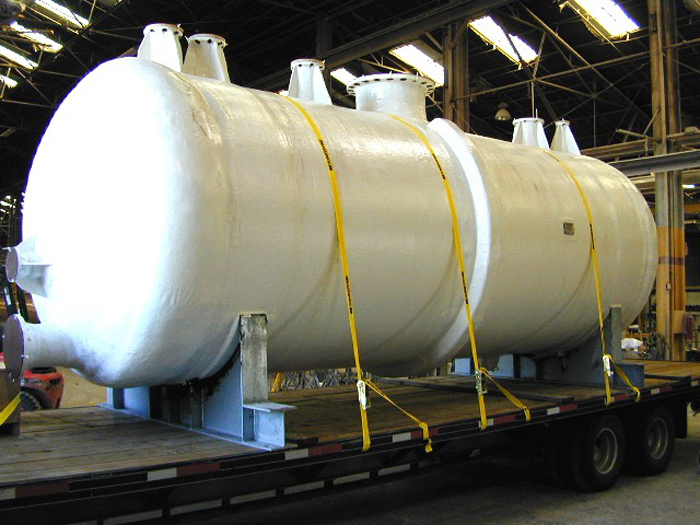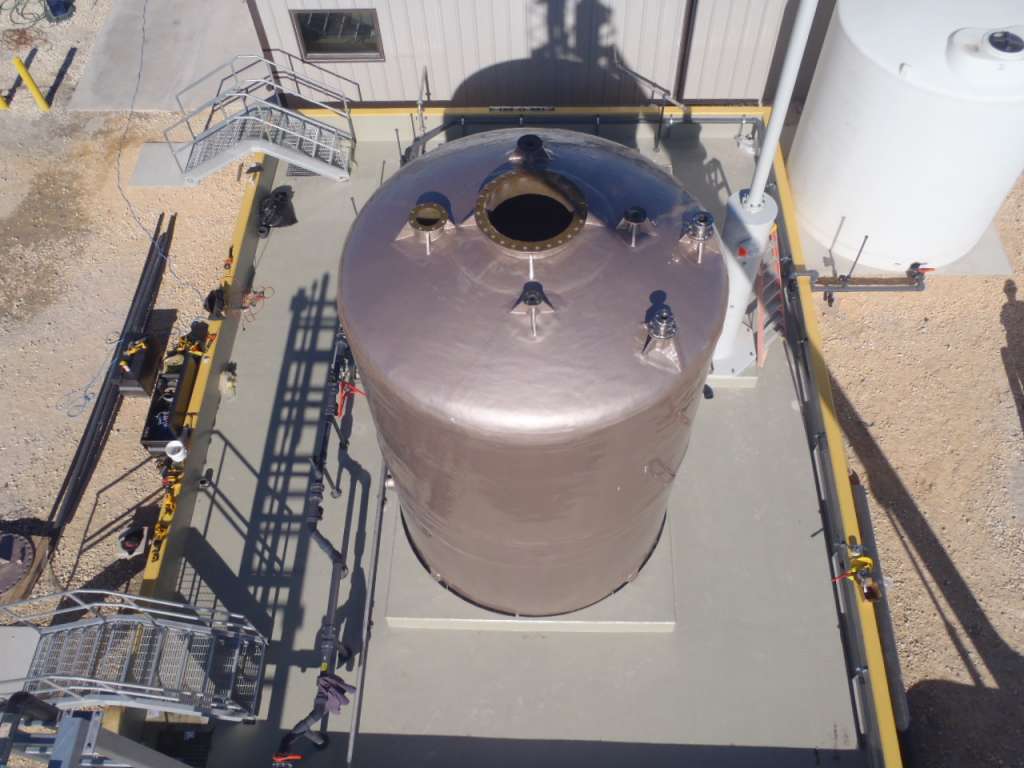Fiberglass Tanks and the Storage of Caustic Soda
 Liquid caustic soda is corrosive. Currently caustic soda is stored in fiberglass, stainless steel, carbon steel, low-carbon steel, lined steel and plastic materials. The nature of the service environment, including the temperature and concentration, will largely determine which materials are most appropriate. Due to the dynamic nature of chemical storage and chemical processes, it is important to not search for a panacea. Instead there are many opportunities for employing a multitude of materials, where fiberglass can be an excellent choice, depending on circumstance. For example, when storing caustic soda, stress cracking and embrittlement in unlined soft steel has been know to occur when liquid temperatures exceed 45 degrees Celsius. Other considerations such as the use of compressed air during unloading will affect the choice of materials and also operating conditions with respect to those materials.
Liquid caustic soda is corrosive. Currently caustic soda is stored in fiberglass, stainless steel, carbon steel, low-carbon steel, lined steel and plastic materials. The nature of the service environment, including the temperature and concentration, will largely determine which materials are most appropriate. Due to the dynamic nature of chemical storage and chemical processes, it is important to not search for a panacea. Instead there are many opportunities for employing a multitude of materials, where fiberglass can be an excellent choice, depending on circumstance. For example, when storing caustic soda, stress cracking and embrittlement in unlined soft steel has been know to occur when liquid temperatures exceed 45 degrees Celsius. Other considerations such as the use of compressed air during unloading will affect the choice of materials and also operating conditions with respect to those materials.
Storage materials are just one facet of the much larger framework, which once must consider with respect to design elements. Other considerations may likely include, but are not limited to, cavitation, solidification, pressure, vacuum, filling lines, vent lines, overflow lines, tank fluid measurements, tank foundations, tank supports and secondary containment structures when specified by relevant laws and regulations.
The purpose of this article is to identify fiberglass as a key caustic soda storage material, identify benefits of using fiberglass for the storage of corrosive materials and to outline Beetle’s custom tank offerings. A key takeaway from this article is evident when endusers, leverage the inherent strengths of fiberglass, specifically long life cycles, whereby degrees of cost-effectiveness may be realized. Another key takeaway relates to the enhancement of complex design through integration; the constructability of our fiberglass materials imparts the ability to interface to pre-existing design elements or infrastructure; this point also emphasizes design flexibility as a key characteristic of fiberglass in general.
The edict that fiberglass is an excellent corrosive storage material, with many benefits passed on to end-users, is not new. Many scholars and industry professionals alike have cogently argued that fiberglass is a superior construction material when one considers the entirety of its benefits portfolio. The key benefits of fiberglass pertinent to this topic include: light-weight, high strength-to-weight ratio, corrosion resistance via customizable corrosion barriers or liners, ease of repair, non-reactive, reduced-maintenance costs, durability, constructability and cost-effectiveness.
Beetle offers single-source design build capabilities combined with over 50 years of fiberglass experience; our products are venerated by a multitude of industries because we understand how to execute and deliver custom fiberglass products. Our tanks and vessels are employed in broad range of applications; we offer horizontal tanks, vertical tanks, chemical storage tanks, chemical vessels, as well as, transport tankers. We offer standard diameters up to 14 feet, with custom diameters available, standard materials or custom formulations.
When designing corrosion resistant fiberglass materials for caustic soda, hydrochloric acid, sulfuric acid, or any other corrosive substance the corrosion barrier will be critical. The corrosion barrier is typically fabricated with a resin-rich liner or corrosion barrier, followed by a glass-rich structural wall. The corrosion barrier is one component of the entire laminates schedule; it is a critical layer that must be designed properly in order to ensure effectiveness, safety and performance of your fiberglass product. We hope that this article has provided you with some basic details regarding fiberglass as an effective material of construction for caustic soda and other corrosives.






